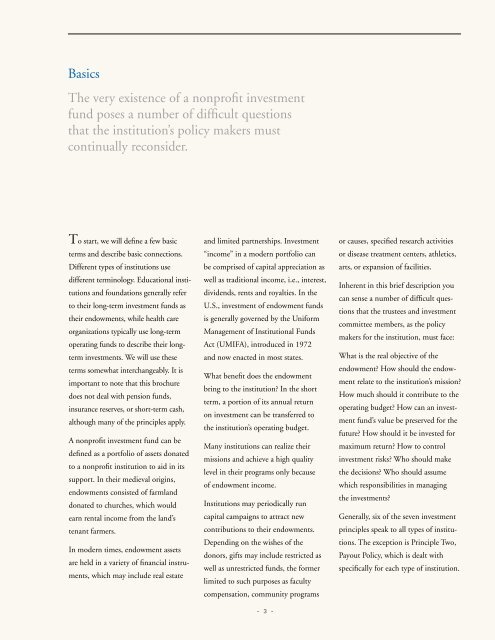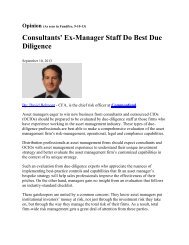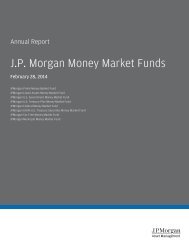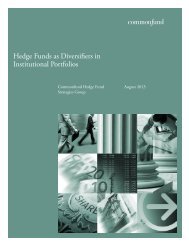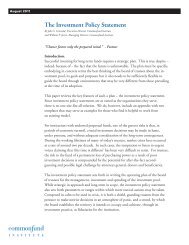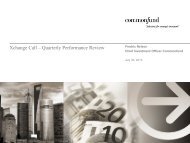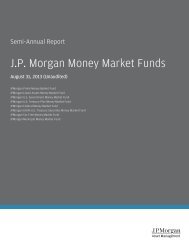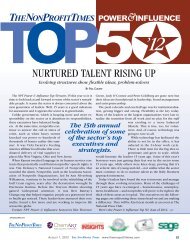Principles of Nonprofit Investment Management - Commonfund
Principles of Nonprofit Investment Management - Commonfund
Principles of Nonprofit Investment Management - Commonfund
Create successful ePaper yourself
Turn your PDF publications into a flip-book with our unique Google optimized e-Paper software.
BasicsThe very existence <strong>of</strong> a nonpr<strong>of</strong>it investmentfund poses a number <strong>of</strong> difficult questionsthat the institution’s policy makers mustcontinually reconsider.To start, we will define a few basicterms and describe basic connections.Different types <strong>of</strong> institutions usedifferent terminology. Educational institutionsand foundations generally referto their long-term investment funds astheir endowments, while health careorganizations typically use long-termoperating funds to describe their longterminvestments. We will use theseterms somewhat interchangeably. It isimportant to note that this brochuredoes not deal with pension funds,insurance reserves, or short-term cash,although many <strong>of</strong> the principles apply.A nonpr<strong>of</strong>it investment fund can bedefined as a portfolio <strong>of</strong> assets donatedto a nonpr<strong>of</strong>it institution to aid in itssupport. In their medieval origins,endowments consisted <strong>of</strong> farmlanddonated to churches, which wouldearn rental income from the land’stenant farmers.In modern times, endowment assetsare held in a variety <strong>of</strong> financial instruments,which may include real estateand limited partnerships. <strong>Investment</strong>“income” in a modern portfolio canbe comprised <strong>of</strong> capital appreciation aswell as traditional income, i.e., interest,dividends, rents and royalties. In theU.S., investment <strong>of</strong> endowment fundsis generally governed by the Uniform<strong>Management</strong> <strong>of</strong> Institutional FundsAct (UMIFA), introduced in 1972and now enacted in most states.What benefit does the endowmentbring to the institution? In the shortterm, a portion <strong>of</strong> its annual returnon investment can be transferred tothe institution’s operating budget.Many institutions can realize theirmissions and achieve a high qualitylevel in their programs only because<strong>of</strong> endowment income.Institutions may periodically runcapital campaigns to attract newcontributions to their endowments.Depending on the wishes <strong>of</strong> thedonors, gifts may include restricted aswell as unrestricted funds, the formerlimited to such purposes as facultycompensation, community programs- 3 -or causes, specified research activitiesor disease treatment centers, athletics,arts, or expansion <strong>of</strong> facilities.Inherent in this brief description youcan sense a number <strong>of</strong> difficult questionsthat the trustees and investmentcommittee members, as the policymakers for the institution, must face:What is the real objective <strong>of</strong> theendowment? How should the endowmentrelate to the institution’s mission?How much should it contribute to theoperating budget? How can an investmentfund’s value be preserved for thefuture? How should it be invested formaximum return? How to controlinvestment risks? Who should makethe decisions? Who should assumewhich responsibilities in managingthe investments?Generally, six <strong>of</strong> the seven investmentprinciples speak to all types <strong>of</strong> institutions.The exception is Principle Two,Payout Policy, which is dealt withspecifically for each type <strong>of</strong> institution.


